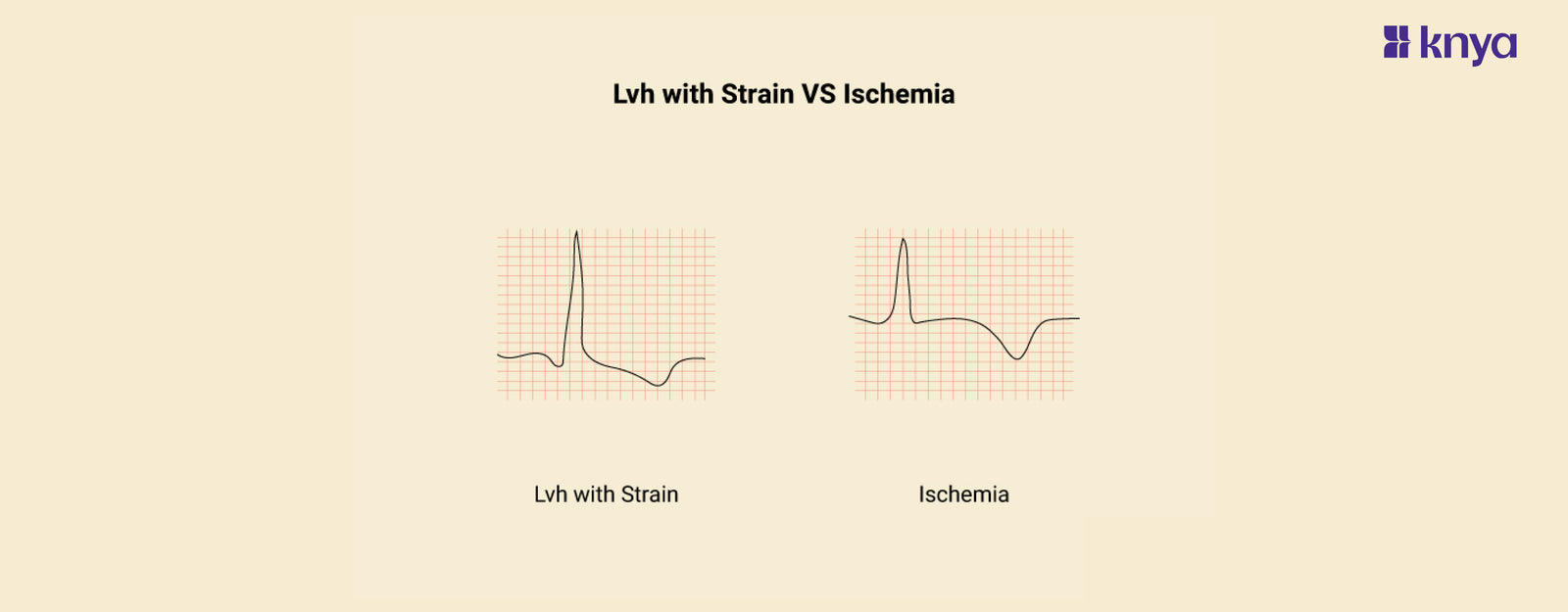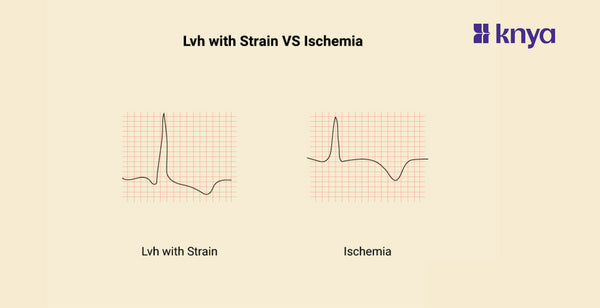Difference between LVH with Strain and Ischemia: LVH with Strain pattern, which displays ST-segment depression and T-wave inversion, represents persistent pressure overload on the heart, frequently brought on by diseases like hypertension. Ischemia, which manifests as ST-segment abnormalities with T-wave inversion, is the consequence of insufficient blood flow brought on by coronary artery disease. Even though both illnesses include aberrant ECG readings, ischemia necessitates immediate action to prevent acute cardiac events, whereas LVH requires the therapy of underlying problems.
Difference between LVH With Strain and Ischemia
LVH with a Strain pattern implies chronic pressure overload in the left ventricle, whereas ischemia shows insufficient blood supply owing to coronary artery disease. LVH suggests possible malfunction of the ventricles, whereas ischemia indicates a higher risk of acute coronary events that require immediate attention. The table below shows the differences between LVH with Strain and Ischemia.
|
Aspect |
LVH with Strain |
Ischemia |
|
ECG Findings |
ST-segment depression and T-wave inversion in the lateral precordial and limb leads |
ST-segment depression or elevation, accompanied by T-wave inversion, often in multiple leads |
|
Underlying Cause |
Chronic pressure overload on the left ventricle, typically from hypertension or aortic stenosis |
Inadequate blood supply to the myocardium, commonly due to coronary artery disease |
|
Pathophysiological Basis |
Reflects increased myocardial workload and potential impairment of ventricular function |
Results from compromised oxygen delivery to the heart muscle |
|
Clinical Implications |
Indicates chronic pressure overload on the heart and may lead to ventricular dysfunction |
Suggests insufficient blood supply to the heart and may precede acute coronary events |
|
Management |
Requires evaluation and treatment of underlying conditions contributing to LVH |
Demands prompt assessment and intervention to mitigate the risk of acute cardiac events |
Browse The Best Scrubs Collection!
What is LVH with Strain?
LVH with Strain pattern on an electrocardiogram (ECG) depicts the heart's response to sustained pressure overload, particularly in hypertension or aortic stenosis. T-wave inversion and ST-segment depression are the main symptoms of this pattern, which mostly affects the limb leads and lateral precordial. It suggests a higher workload for the heart and possible ventricular dysfunction. Even while LVH is a compensatory mechanism meant to keep the heart pumping, the strain pattern points to a more advanced stage that could have negative consequences if addressed.
Features of LVH with Strain
- ST-Segment Depression: Distinguished by a downward shift of the ST segment, frequently observed in the limb leads (I, aVL) and lateral precordial leads (V4-V6).
- T-Wave Inversion: T waves that are inverted appear alongside an ST-segment depression, which suggests that the myocardium is under more stress.
- Lateral Lead Predominance: The distribution of left ventricular hypertrophy is reflected by the strain pattern, which is most noticeable in the lateral precordial and limb leads.
- Elevated QRS Voltage: Due to the hypertrophied myocardial, LVH with Strain may also exhibit elevated QRS voltage.
- Possible Impairment of Ventricular Function: If treatment is not received, the strain pattern points to an increasing workload and strain on the heart, which could result in ventricular dysfunction.
Causes of LVH with Strain
- Chronic left ventricular pressure overload is often brought on by either aortic stenosis or hypertension.
- The hereditary disorder known as hypertrophic cardiomyopathy is characterized by the thickening of the heart muscle.
- Excessive physical exertion or athletic training that causes physiological LVH.
- Aortic regurgitation or coarctation of the aorta are two more underlying cardiac diseases that put a persistent load on the heart.
Symptoms of LVH with strain
- Discomfort or pain in the chest
- Breathlessness
- Weakness or exhaustion
- Exercise inefficiency or a decreased capacity for exercise
- Heart irregularities, or arrhythmias
- Heart palpitations
- Feeling lightheaded or dizzy
- Experiencing syncope
- Swelling of the ankles or legs, called edema
What is Ischemia?
Ischemia is a medical term that refers to a situation in which the body's tissues or organs receive less blood flow and oxygen. It is usually caused by restricted or clogged blood arteries, which prevents enough oxygen-rich blood from reaching the affected area. Ischemia can affect any organ or tissue in the body, including the heart, brain, limbs, and intestines. The absence of oxygen and nutrients in ischemic tissues can cause cellular injury, malfunction, and, in severe and prolonged cases, tissue death (necrosis). Ischemia can be caused by a variety of diseases, including atherosclerosis, thrombosis, embolism, vasospasm, or trauma.
Features of Ischemia
- Pain or discomfort: Ischemia frequently causes pain or discomfort in the affected location, such as chest pain (angina) in coronary Ischemia or limb pain in peripheral ischemia.
- Pallor: Skin paleness caused by diminished blood flow and oxygenation to the tissues. The affected area may feel chilly to the touch due to diminished blood flow.
- Weakness or Numbness: Reduced function or feeling in the affected area as a result of insufficient oxygen and nutrient availability to the nerves and muscles.
- Risk Factors: Ischemia may develop more commonly in people who have atherosclerosis, hypertension, diabetes, smoking, obesity, or a sedentary lifestyle.
- Triggers: Physical exercise, stress, cold temperatures, and certain drugs can all cause or worsen Ischemia.
Causes of Ischemia
- Atherosclerosis is the buildup of plaque within the arteries, which causes constriction and restricted blood flow. This is a prevalent cause of coronary artery disease, peripheral artery disease, and cerebrovascular illness.
- Thrombosis is the formation of blood clots within blood vessels, which can occlude the vessel and prevent blood flow. Endothelial injury, hypercoagulable conditions, or sluggish blood flow are all potential causes of thrombosis.
- Embolism is the movement of a blood clot (embolus) from one portion of the body to another, where it becomes trapped in a smaller artery and disrupts blood flow. Emboli can come from the heart (atrial fibrillation, myocardial infarction), deep vein thrombosis, or arterial plaques.
- Vasospasm is the constriction or narrowing of blood vessels caused by an abnormal contraction of smooth muscle in the vessel walls. Vasospasms can occur spontaneously or be caused by several causes, including cold exposure, stress, and some drugs.
- Damage to blood vessels or tissues, such as from blunt trauma, penetrating injuries, or surgical procedures, can disrupt blood flow and result in ischemia.
Symptoms of Ischemia
- Numbness
- Confusion
- Fatigue
- Cognitive alterations
- Chest discomfort
- Shortness of breath
- Weakness
- Altered sensation
- Motor deficiencies
Shop Best Lab Coats From Here!
Similarities between LVH with Strain and Ischemia
- An electrocardiogram (ECG) may show abnormalities in both diseases.
- They might exhibit abnormalities in the ST segment, such as depression or elevation.
- Both strain and ischemia-related LVH may point to underlying heart disease, necessitating additional testing to identify the underlying cause.
- If treatment is not received, they are both linked to a higher risk of serious cardiac events.
- For both disorders, prompt diagnosis and effective treatment are crucial to avoiding complications and achieving better results.
In summary, although both disorders can present with aberrant ECG readings and suggest cardiac illness, chronic pressure overload on the heart is the primary cause of LVH with strain, while inadequate blood supply to the myocardium is indicated by ischemia. Comprehending these distinctions is essential for suitable clinical handling.
Order the Best Jogger Scrub From Here!
| Check out More Articles | |
| Difference Between Tendon and Ligament | |
| Difference Between Seizure and Epilepsy | |
| Difference Between Hypothyroidism and Hyperthyroidism | |















